The Gran Teatre del Liceu
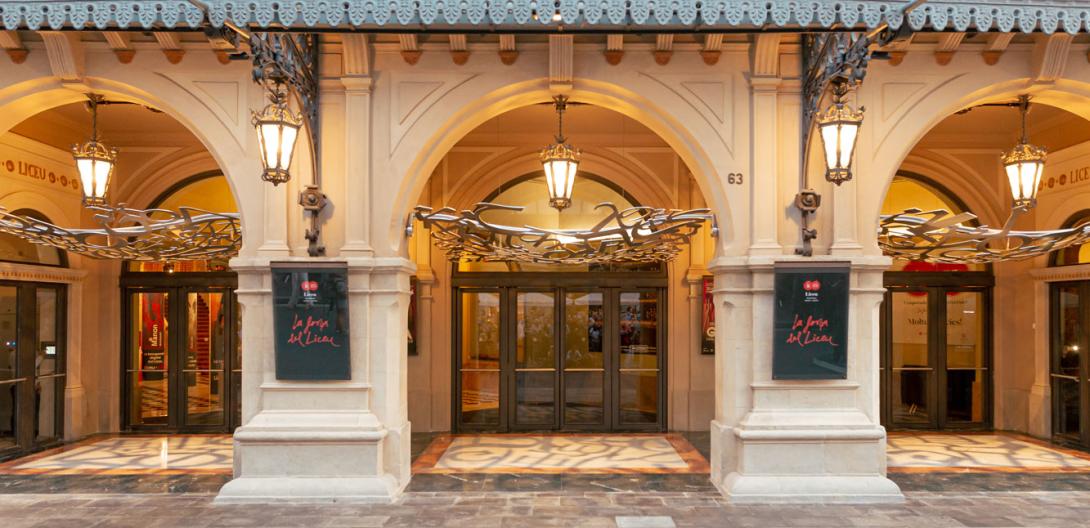
Origin
The beginnings of the Gran Teatre del Liceu date back to 1837 when a battalion of the Milícia Nacional, at the initiative of Manuel Gibert, created the institutional nucleus of the future opera house in the disaffected Montsió convent (now Portal de l'Àngel): an amateur dramatics society for cultivating the performing arts. On 21 August, 1837, the first performance of Ventura de la Vega's El marido de mí mujer, was held, together with a dance and a sainete (one-act farce).
In 1838, the partners decided to go a step further and add a teaching dimension to the project, with the aim of putting it on a par with the Conservatorio de Musica y Declamación de Maria Cristina in Madrid. This was the birth of the Liceo Filarmonico Dramatico Barcelonés, the purpose of which was to promote theatrical and musical education. The same year they obtained permission to include the Queen's name: Liceu Filarmónico Dramático Barcelonés de S.M. la Reina Isabel II (Barcelona Philharmonic and Dramatic Lyceum of H.M. Queen Isabella II). The Liceu consisted of shareholder members, contributors or season ticket holders and students of the professors, who received their tuition in exchange for free stage performances.
In1844, Joaquim de Gispert i d’Anglí's partner was entrusted with the task of finding a new site on which to construct a building to house the teaching departments and a theatre, as well as to devise a formula for financing the project. The space chosen was the former Trinitarian convent on La Rambla. The purchase of the building was formalised on 9 June, 1844, with very favourable financial conditions for the Liceu.
The financing project took shape with the creation of two companies: firstly the Sociedad de Construcción, the building company, made up of the Liceu Filharmònic and shareholders from wealthy families who, in exchange for their financial inputs, received the right to use 50% of the stalls and seats in perpetuity.
As the solution initially provided was financially insufficient, a new auxiliary construction company, the Sociedad auxiliar de Construcción, was set up to provide the rest of the money in exchange for the ownership of other areas of the building in which shops and the Cercle del Liceu private club were housed.
Unlike other European cities in which the monarchy had actively participated in the construction of the great opera houses, the Liceu was built on private contributions, meaning that a large part of the theatre was owned by very few families.
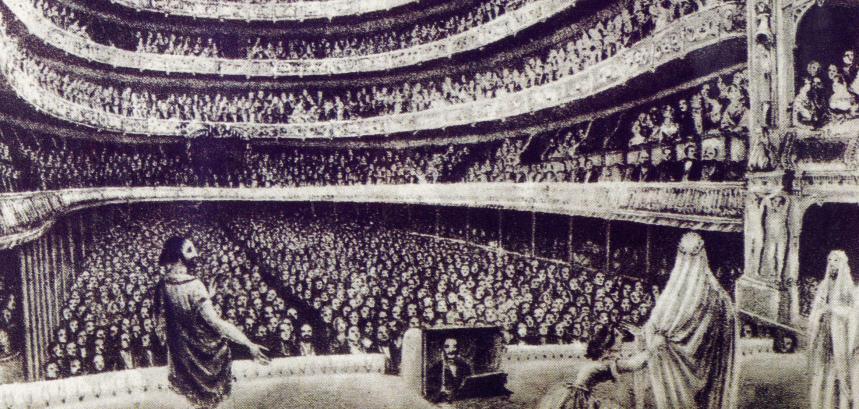
The first Liceu 1847-1861
The foundation stone of the new Theater was laid in April 1845. The architect Miquel Garriga was in charge of the construction and directed the works until 1846, when he was replaced by Josep Oriol Mestres.
On April 4, 1847, Easter Sunday, the Theater was inaugurated with significant public impact. The program included a symphony by Juan Melchor Gomis, the drama Don Fernando el de Antequera by Ventura de la Vega, an Andalusian-style dance titled Rondeña by José Jurch with choreography by Joan Camprubí, a cantata in Italian by Joan Cortada with music by Mariano Obiols titled Il regio imene. Opera arrived a few days later, on April 17, with Anna Bolena. The new Theater had the largest seating capacity in Europe, accommodating 3,500 spectators, and the stage was equipped with the most modern facilities and technology of that time.
From its inauguration, the Gran Teatre del Liceu and the Teatre Principal were in constant competition. This rivalry focused on obtaining the best programs, being the first to premiere the most successful titles, and hiring the best singers. Until the late 19th century, the Principal maintained primacy, but from then on, the Liceu, being more innovative and wealthy, became the city's grand theater. The rivalries between the Liceístas and Cruzados spectators occasionally led to altercations, as beyond the artistic conflict, there was a confrontation between two ways of understanding the bourgeoisie and civic power.
It soon became evident that the Liceu did not yield the expected profits, which strained the relationship between the seat owners and the Liceo Filarmónico (now the Higher Conservatory of Music of the Liceu). Thus, in 1854, the separation of the two entities was agreed upon. On December 31, 1854, the Regulations for the regime and government of the Society of the Gran Teatre del Liceu were promulgated, and the theater's direction, ownership, and governance exclusively depended on the shareholders' society, which from that moment would be called the Society of the Gran Teatre del Liceu.
The Society of the Gran Teatre del Liceu never operated the Theater directly; it was the governing Board that chose the "performance companies" that rented it out by season. These companies committed to offering a certain number of performances and managed the season's programming. The performance company was also responsible for the orchestra, props, and costumes, as well as the building's supply expenses; it was also obliged to provide part of the scenery to the Society. In return, it received the income from the sale of seats not allocated to the Society.
The first theater had a short life of 14 years; on April 9, 1861, a fire that started in the tailor's shop quickly spread and completely destroyed the hall and stage. The theater was reduced to rubble, and the owners unanimously decided to rebuild it, sharing the costs among all the shareholders and interested parties. Barcelona earned general admiration as the Coliseum was rebuilt in a year, led by architect Josep Oriol Mestres, again without funding from the Royal House.
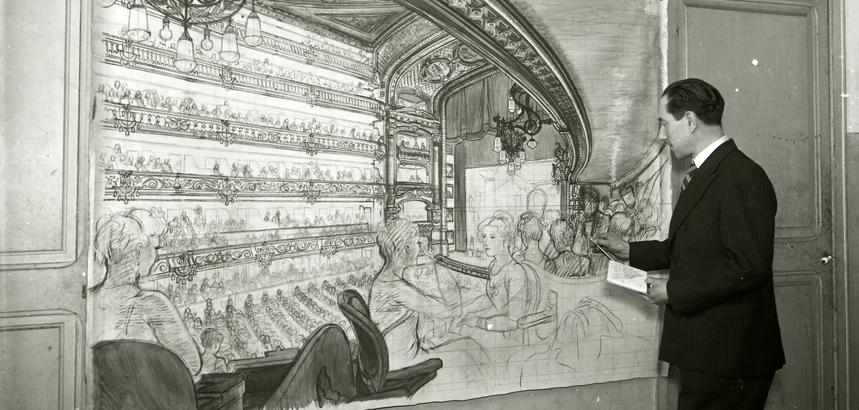
The second Liceu 1861-1994
The Liceu reopened its doors in April 1862 with the opera I Puritani, preceded by a symphonic piece Las dos lápidas by Joan Sariols i Porta (the winning composition of the competition organized for the inauguration of the new Theater).
The Liceu's audience was very diverse. The boxes and the stalls were occupied by the great families of the bourgeoisie and local aristocracy, and as the seats ascended to higher floors, the social composition changed. Music enthusiasts and members of the petite bourgeoisie gathered there, and on the fifth floor, the working class. However, the Liceu had always been identified with the bourgeoisie. Beyond its function as a performance hall, it was a meeting place and a venue for festivities with masquerade balls, a display of wealth, and where business and marriages were arranged. The fact that the Liceu became a symbol of the oligarchy made it a target for the revolutionary proletariat, which, in the late 19th century, was strongly influenced by Italian anarchist movements that used direct action or “propaganda by deed” as a means of fighting the ruling classes. On November 7, 1893, during the opening performance of the season, in the second act of Guillaume Tell, the anarchist Santiago Salvador threw two Orsini bombs into the stalls, of which only one exploded, resulting in 20 victims and numerous injuries. After that day, the Liceu closed its doors and did not resume artistic activities until January 18, 1894, with a series of concerts conducted by maestro Antoni Nicolau. The attack left a climate of fear among the bourgeoisie, and the boxes and seats took a long time to fill again as usual.
The Theater remained in the hands of the Society of the Gran Teatre del Liceu until the outbreak of the Civil War when the Theater was nationalized by the Generalitat de Catalunya. This nationalization was formalized in the Decree of July 27, 1936, through which the Liceu was renamed the National Theater of Catalonia. Three days later, the Comisaría de Espectáculos (Entertainment Commission) of the Generalitat was installed in the lower levels of the Círculo del Liceo, and on August 5, 1936, an annex to the decree nationalized the Círculo and the Conservatory as well.
By the late 1970s, the funding system was entirely obsolete compared to the major opera houses in Europe. In 1980, with the death of the last entrepreneur, Joan Antoni Pàmias, the Catalan administrations became aware of the historical and cultural value of the institution, and on December 11, through a decree of the Generalitat, the Consorci del Gran Teatre del Liceu was created. Initially, it comprised the Generalitat itself, the Barcelona City Council, and the Society of the Gran Teatre del Liceu; later, the Barcelona Provincial Council and the Ministry of Culture were added. Despite the creation of the Consortium and the introduction of public funding, the theater’s financial deficit could not be halted.
The establishment of the consortium resulted in the direct management of the theater being placed in the hands of public administrations. The Consortium appointed the people responsible for the management and programming of the Liceu, initially Lluís Portabella, manager of Pro-Música, as manager, and Lluís Maria Andreu, as administrator and artistic director. Despite the increased contributions from public administrations, the deficit continued to grow to truly alarming proportions.
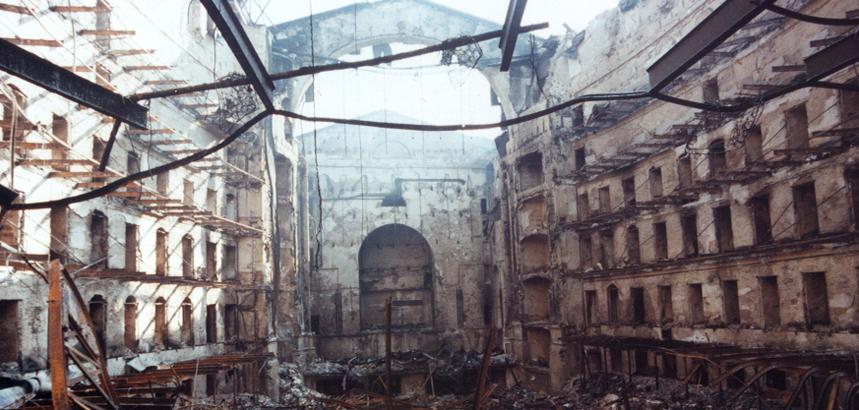
Fire and reconstruction
The fire on January 31, 1994, caused a profound emotional impact and a strong and cohesive citizen response. On the same day as the fire, the board of the Consortium unanimously agreed to rebuild the Liceu on the same site. The project was commissioned to architect Ignacio de Solà-Morales, with Xavier Fabré and Lluís Dilmé joining the team.
Parallel to the beginning of the Theater's reconstruction, the Consortium decided not to halt the artistic programming, based on the conviction that the Liceu was not just the building, but was primarily constituted by its audience and the art created there. The artistic activity continued in other important performance spaces in the city: the Palau de la Música Catalana, the Teatre Victoria, the Mercat de les Flors, the Teatre Nacional de Catalunya, or the Palau Sant Jordi, among others.
To reconstruct, improve, and expand the emblematic building, a new legal approach was necessary regarding its public ownership. On September 5, 1994, the Gran Teatre del Liceu Foundation was established in a solemn ceremony in the Hall of Mirrors. On the same day, the ownership of the Society of the Gran Teatre del Liceu was transferred to public administrations.
On February 1, 1995, the Patronage Council was established to encourage private financing for the Theater's reconstruction and to ensure the continued corporate support for the Liceu project.
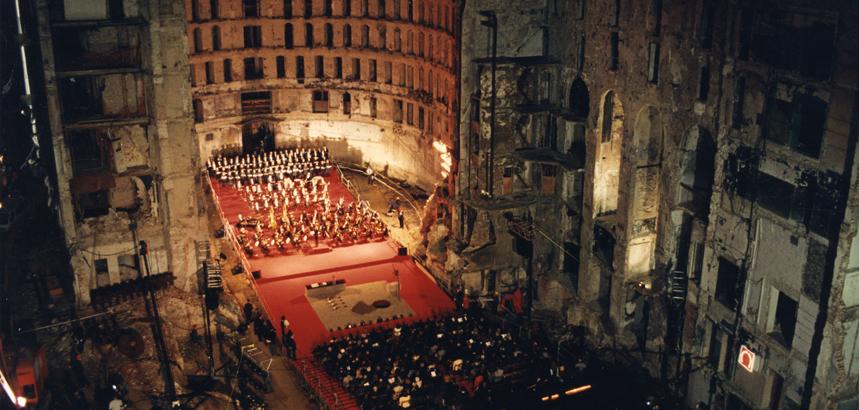
The third Theatre
On October 7, 1999, the inaugural performance of the new Theater took place with Turandot under the stage direction of Núria Espert. The new building retained a faithful appearance to its predecessor but was equipped with advanced technical infrastructure.
The Liceu was reborn as a cultural project aimed at society as a whole. The new Theater opened its doors as a public theater, with the mission of creating aesthetically ambitious art that reaches the widest possible audience and of enhancing artistic opportunities for the country's musicians and creators.
Joan Matabosch assumed the artistic direction of the new Theater until 2014. During his tenure, he showed a great interest in not repeating established values—titles, productions, singers—but instead sought to innovate with proposals that fostered the identification of opera as a living and constantly evolving art form.
In June 2014, Christina Scheppelmann took over as the artistic director of the Theater. For five years, she orchestrated balanced and high-quality seasons without abandoning innovation, engaging great voices, and showing a strong interest in bringing opera closer to younger audiences. From the 19/20 season, Víctor Garcia de Gomar joined as the artistic director of the Coliseum.
Since the reconstruction, the principal music directors have been Bertrand de Billy (1999-2004), Sebastian Weigle (2004-2008), Michael Boder (2008-2012), and, since September 2012, Josep Pons.
The artistic history
Espectáculos mixtos y consolidación del repertorio operístico (1847-1893)
On 4 April, 1847, the opera house opened with a mixed programme that included a symphony by Joan Melcior Gomis, the drama Don Fernando el de Antequera by Ventura de la Vega, a dance entitled Rondeña by Josep Jurch and Il regio imene, a cantata by Joan Cortada with music by Marià Obiols.
In the early years, the shows were structured around a play, an opera, a zarzuela, a ballet or a concert, with frequent interludes of a wide range of magic, tightrope walking or conjuring acts.
The Lent programme was reserved for strictly musical shows, and during Carnival, masked balls and masquerade balls were organised, following a tradition that was widespread throughout Europe. The enormous variety of shows attracted a wide range of people from very different sectors of society, who filled the auditorium every day. During this early period, opera accounted for approximately 25% of the performances.
The first opera to be heard at the Theatre was Donizetti's Anna Bolena (1847). During the early years, the programme primarily featured Italian opera, with a significant proportion of works by Rossini, Bellini and Donizetti. Works by Verdi were also incorporated from the first year. French opera was introduced more slowly, but soon gained prominence, as the characteristics of grand opéra were perfectly suited to the grandeur of the Liceu, with the obligatory presence of ballet, large choral ensembles and impressive scenery. The most frequently performed composers of this period were Meyerbeer, Halévy and Thomas.
Wagnerism and the Golden Years 1893-1939
It was in 1863 that the first Wagnerian notes rang out at the opera house in a performance in which the Theatre's chorus and the Societat Coral Euterpe choral society sang the Tannhäuser march under the baton of Josep Anselm Clavé. But it was not until March 1883 that Wagner's first opera was performed at the Liceu: Lohengrin, which opened the previous year at the Teatre Principal. The artistic and architectural conditions of the Liceu made it the city's most suitable venue for the staging of Wagnerian dramas. Der fliegende Holländer (1885) and Tannhäuser (1887) followed soon after. Wagnerian fervour grew, and 1899 saw the first performances of Die Walküre and Tristan und Isolde, which opened the 1899/1900 season to great public acclaim. Wagner's presence at the Liceu continued unabated during the early decades of the 20th century, with the Festivals Wagner (spring 1910/11) and the opening of Parsifal, a work that until 1914 could only be performed in its entirety in Bayreuth. Barcelona wanted to be the first city in the world to stage it legally and scheduled it for 31 December, 1913. Wagnerian operas performed during this period have remained in the Liceu's programme right up to the present day.
In the 1880s, a programming structure was developed based on assigning genres to each of the seasons: the winter season was devoted exclusively to opera, the Lent season alternated between concerts, ballet and operetta, and the spring season was devoted to opera and operetta.
As for Italian opera, a repertoire of this was developing and audiences were becoming somewhat accustomed to it. In these seasons, the public showed a particular taste for verismo operas. In this sense, noteworthy performances included the Liceu premieres of Mascagni's Cavalleria rusticana, Iris, Amica (directed by the composer himself), Leoncavallo's Pagliaccio, Manon Lescaut, La bohème and Puccini's Tosca, among many others.
In 1885, the first Catalan opera was premiered at the Liceu, Artur Baratta's Lo desengany and in the same period, Sánchez Gavagnach premiered La messaggiera, Tomás Bretón Los amantes de Teruel and Garín; Felip Pedrell, Quasimodo, L’ultimo Abenzerraggio and I Pirinei, and before the end of the century Pepita Jiménez and Henry Clifford (conducted by Isaac Albéniz himself) were also performed.
From the closing decades of the 19th century, the public's passion for iconic voices was consolidated with the legendary tenor Mario, Antonio Superchi, Francisco Tamagno, Marietta Alboni, Roberto Stagno, Julián Gayarre, Gemma Bellincioni, Hariclea Darclée, Rosina Storchio, Victor Maurel, Angelo Masini, Ramón Blanchart, Alessandro Bonci, Enrico Caruso, and Tita Ruffo, among many others. During this period, a number of Catalan singers made their debuts at the opera house and went on to achieve international acclaim, including Francesc Viñas, Josep Palet, Andreua Avel·lina Carrera, Carme Bonaplata, Josefina Huguet, Elvira de Hidalgo, Maria Barrientos, Graziella Pareto and Conxita Supervia.
Symphonic music was gaining prominence thanks to the Lent seasons which attracted conductors such as Joan Goula, Antoni Nicolau, Richard Strauss, Pablo Sarasate, Edoardo Mascheroni, Arturo Toscanini, Joan Lamote de Grignon, Saint-Saëns, Franz Beidler, and Gabriel Fauré to the Theatre, among many others.
Ballet became important as a unique part of each performance. Some of the works most beloved by the public were Messalina by Giuseppe Giaquinto, Rodope by Paolo Giorza and Coppélia by Léo Delibes.
Russian opera became popular in the first decades of the 20th century. In 1915, Mussorgsky's Boris Godunov was first performed, a work that was to be present in practically every season. Tchaikovsky and Rimsky-Korsakov were also successfully performed at the Theatre, particularly The Legend of the Invisible City of Kitezh (1926), one of the most popular works in the Russian repertoire.
The imbalance between regular and one-off works became more pronounced, and Italian opera, with Verdi and Puccini at the forefront, continued to represent the bulk of the Theatre's programme. The same phenomenon occurred with the French repertoire, with the prioritisation of composers such as Bizet, Gounod, Massenet, Bizet, and Charpentier. During this period, German opera was also very prominent, represented by Wagner, Mozart and Strauss. Opera by local composers was maintained with a certain degree of continuity, featuring composers such as Enric Morera (Tassarba, Empòrium, Bruniselda and Titaina); Jaume Pahissa (La morisca, La princesa Margarida and Gal·la Placídia); and Amadeu Vives (Maruxa, Balada de Carnaval, Doña Francisquita and Euda Uriach)
During the inter-war period, a series of singers became established at the opera house thanks to their great voices and their rapport with the public. Among the most popular were Mercè Capsir, Maria Gay, Maria Espinalt, Hipòlit Lázaro, Miguel Fleta, Feodor Chaliapin, Beniamino Gigli Aureliano Pertile, Riccardo Stracciari, Tito Schipa, Mattia Battistini, Giacomo Lauri-Volpi, John O’Sullivan, Lauritz Melchior, Fiodor Chaliapine, and Pau Civil.
From 1917 onwards, ballet took on a major role in the Theatre's programming, notably due to Sergei Diaghilev's Ballets Russes, which featured internationally famous dancers such as Nikinsky, the Viennese Ballets, the Paris Opera Ballet, the Ballets Russes de Monte Carlo and the famous ballerina Anna Pavlova. The Theatre's ballet company became independent, presenting its own choreographies.
The Lent concerts were again very popular from the 1920s onwards. In May 1923, the Pau Casals Orchestra began to collaborate with the Liceu. Both this orchestra and that of the Theatre were conducted by such important maestros as Igor Stravinsky, Richard Strauss, Max von Schillings, Alexander von Zemlinsky, Manuel de Falla, Clemens Krauss, Ottorino Respighi, Alexander Glazunov and Pau Casals himself.
During the years of the Republican Government, the artistic programming focused on Catalan composers with revivals for works like Gal·la Placídia by Pahissa and premieres of Neró and Acté by Joan Manén, Maria del Carmen by Enric Granados, El estudiante de Salamanca by Joan Gaig and El monjo negre by Joaquim Cassadó. Eduard Toldrà's El giravolt de maig, with text by Josep Carner, performed in 1938, is one of the few Catalan operas from this period to survive in the repertoire.
From the end of the war to the creation of the Consortium 1939-1981
The Theatre continued to perform a repertoire that was known and loved by the public, focusing more on the quality of the voices than the scenography, the chorus or orchestra. The most frequently performed works in the season continued to be Italian: Il barbiere di Siviglia, Aida, Rigoletto, La traviata, La bohème and Madama Butterfly; the French repertoire was reduced to Carmen, Faust, Manon, Samson et Dalila and Werther. In the Germanic world, the absolute primacy of Wagnerian titles continued, with Tristan und Isolde, Die Walküre and Lohengrin being on a par in terms of programming with the more popular Italian titles. Mozart was fully ensconced in the repertoire, particularly Le nozze di Figaro, followed by Don Giovanni, Così fan tutte, Die Entführung aus dem Serail and Die Zauberflöte; Strauss was reduced to three major titles Der Rosenkavalier, Salome and Elektra. Between 1939 and 1944, the company that played most frequently was Oper Frankfurt. A unique event in the Liceu's artistic history was the visit of the Bayreuth Festival in the spring of 1955, which took the form of the Festivals Wagner with the innovative stage proposals of Wieland Wagner.
Of particular note from this period were the performances of contemporary Italian operas which represented an evolution from the previous romantic and veristic trends. Noteworthy composers included Salvatore Allegra, Licinio Recife, Vieri Tosatti, Jacopo Napoli, Ildebrando Pizzetti, Renzo Rossellini, Gianfranco Menotti, Luciano Chaily and Raffaello de Banfield.
The Liceu's long-standing passion for great voices was particularly fortunate in these years, as the most important figures in the international lyric scene performed on the stage. Between the audience and these artists there was a grateful and devoted relationship that made these artists legends and ensured the continuity of the Theatre.
Three sopranos stand out for their personal connection with the Theatre: Victoria de los Ángeles who fascinated the public with her pure and elegant style from her debut with the Countess in Le nozze di Figaro. Renata Tebaldi, already an established soprano at the time of her debut at the Theatre, fascinated the audience to the point of becoming an icon at the Coliseum and in the city. Undoubtedly the artist most closely identified with the Liceu is Montserrat Caballé, both because of her outstanding quality and her presence in the programming for more than 30 years.
Other female voices dear to the public are those of Maria Caniglia, Giulietta Simionato, Ebe Stignani, Fedora Barbieri, Kirsten Flagstad; Elisabeth Schwarzkopf, Gertrude Grob-Prandl, Astrid Várnay, Lisa della Casa, Birgit Nilsson, Maria Callas, Virginia Zeani, Fiorenza Cossotto, Magda Olivero, Grace Bumbry, Joan Sutherland, Renata Scotto, Leyla Gencer, Mirella Freni, Marilyn Horne, Ángeles Gulín, Ghena Dimitrova, Elena Obraztsova, Leonie Rysanek and Edita Gruberová among others.
Two Catalan tenors have moved the audience in a very special way: Jaume Aragall and Josep Carreras. Other highly valued male voices include those of Mario Del Monaco, Giuseppe Di Stefano, Wolfgang Windgassen, Mario Filippeschi, Carlo Bergonzi, Franco Corelli, Alfredo Kraus, Richard Tucker, Plácido Domingo, Eduard Giménez, Dalmau González, Pedro Lavirgen, Luciano Pavarotti, Hans Hotter, Manuel Ausensi, Ettore Bastianini, Piero Cappuccilli, Cornell MacNeil, Vicenç Sardinero, Joan Pons, Carlos Álvarez, Sherrill Milnes, Boris Christoff, Cesare Siepi, Bonaldo Giaiotti, and Nicola Ghiaurov.
Between 1939 and 1981, internationally renowned personalities held the baton at the Theatre, including Napoleone Annovazzi (musical director from 1947-1952), Eugene Ormandy with the Philadelphia Symphony Orchestra (1955), Georg Szell with the Cleveland Orchestra and William Steinberg with the Pittsburg Orchestra (1964), Karl Böhm with the Vienna Philharmonic Orchestra (1965), Herbert von Karajan with the Berlin Philharmonic Orchestra (1972), Georg Solti with the Orchestre de Paris and Lorin Maazel with the New Philharmonia Orchestra of London (1974).
In the field of dance, companies such as the Marqués de Cuevas, Les Ballets de Montecarlo, Ballet de L’Opéra de Paris, New York City Ballet, the Igor Moisseiev Company, Ballet Kirov from Leningrad, companies from Sofia, Belgrade, Prague, Brno, Ballet du Rhin, Òpera Estrasburg, London Festival Ballet and Le Ballet Théâtre Français de Nancy. The Gran Teatre del Liceu's own ballet company was also consolidated under the direction of Joan Magriñà, a position later filled by Assumpta Aguadé.
The Consortium and the Liceu in exile 1981-1999
During the years of Consortium management, the basic operatic repertoire was maintained without too many changes and the number of productions increased. Some of the most frequently performed works were Verdi's Aida, Rigoletto, Il trovatore and La traviata; Wagner's Lohengrin, Die Walküre, Tristan und Isolde, Tannhäuser, and Parsifal; Donizetti's Lucia di Lammermoor, El elisir d'amore, La favorita; Puccini's Tosca, La bohème, Turandot, Madama Butterfly; Bellini's Norma; Rossini's Il barbiere di Siviglia and Richard Strauss' Salome and Elektra.
In this period the theatre opened up to new aesthetic trends and tendencies in contemporary drama with the participation of stage directors such as Josep Montanyès (Cançó d’amor i de guerra, Una cosa rara), Lluís Pasqual (Falstaff, Samson et Dalila), Ricard Salvat (Edip i Jocasta, Tannhäuser), Mario Gas (Un ballo in maschera, Il matrimonio segreto, Jenůfa, L’elisird’amore), Núria Espert (Elektra, Carmen, Turandot), Joan Lluis Bozzo (Rigoletto), Joan Font dels Comediants (Die Zauberflöte), José Luis Alonso (Armide, Doña Francisquita), Emilio Sagi (Mefistofele, Idomeneo), José Carlos Plaza (The Duenna), and others.
The Consortium encouraged the incorporation of some of the great international names in stage direction, who put on innovative shows, not always without controversy, such as Piero Faggioni, Otto Schenk, Giancarlo Del Monaco, Jonathan Miller, Jean-Pierre Ponnelle, Gilbert Deflo, Hans Hollmann, Graham Vick, Michael Hampe, Götz Friedrich, Graham Vick, Steffen Piontek, Harry Kupfer, and Willy Decker to name but a few.
In addition to the presence of the established voices from the previous period, it is worth mentioning the debuts of Simon Estés, Catherine Malfitano, Éva Marton, Marilyn Horne, Dolora Zajick, Aprile Millo, June Anderson, Anna Tomowa-Sintow, Chris Merritt, José van Dam, Cecilia Bartoli, Josep Bros, Debora Voight, Paata Burchuladze, and María Bayo.
Despite the fire on 31 January, 1994, the Consortium decided not to interrupt the artistic programme, which was transferred to other venues in the city. Highlights during these years include works such as The Light house by Davis (1996), The Turn of the Screw by Britten (1996), Le pauvre matelot by Milhaud (1997) and Alcina by Händel, as well as others such as Turandot at Palau Sant Jordi (1994), Tristan und Isolde (1996) and Macbeth (1997) at the Palau de la Música Catalana, Madama Butterfly (1995), Norma (1995), and L’elisir d’amore (1998) at Teatre Victòria among many others.
The Liceu in the 21st century
In terms of dance, some of the most important international companies have passed through the Theatre over the last few years: Alvin Ailey, American Dance Theater, Martha Graham Dance Company, Béjart Ballet Lausanne, Nederlands Dans Theater, Ballet de Zuric, Das Hamburger Ballet, English National Ballet, Ballet de l’Opéra National de Paris, Compañía Antonio Gades, Pina Bausch, Semperoper Ballett and many others.
The children's programme is also gaining momentum, with the creation of El Petit Liceu. The activity on the main stage coexists with other shows held mainly in the Theatre's Foyer with the Golfes sessions and monographic shows to coincide with the opera scheduled at that time, and in the same vein, but initiated some years later, Off Liceu and L'Esclat chamber performances.
Over the years, great voices such as Angela Denoke, Joyce DiDonato, Diana Damrau, Iren Theorin, Sondra Radvanovsky, Jonas Kaufmann, Christian Gerhaher, Juan Diego Flórez, Javier Camarena, Piotr Beczala and many others have performed at the Theatre.

